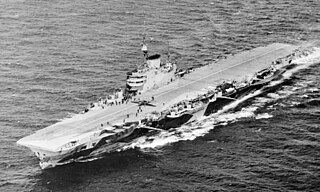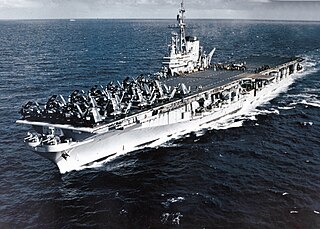 W
WThe Audacious-class aircraft carriers were a class of aircraft carriers proposed by the British government in the 1930s - 1940s and completed after the Second World War. The two ships built were heavily modified and diverged over their service lives. They were in operation from 1951 until 1979.
 W
WThe Clemenceau-class aircraft carriers are a pair of aircraft carriers which served in the French Navy from 1961 until 2000. From 2000 until 2017 one served with the Brazilian Navy as São Paulo. The Clemenceau class was France's first successful aircraft carrier design after World War II and was the backbone of the French Fleet for the duration of its forty years of service.
 W
WThe Courageous class, sometimes called the Glorious class, was the first multi-ship class of aircraft carriers to serve with the Royal Navy. The three ships—Furious, Courageous and Glorious—were originally laid down as Courageous-class battlecruisers as part of the Baltic Project during the First World War. While very fast, their minimal armour and few guns limited their long-term utility in the post-war Royal Navy, and they were laid up after the war. They were considered capital ships by the terms of the 1922 Washington Naval Treaty and were included in the total amount of tonnage allowed to the Royal Navy. Rather than scrap them, the Navy decided to convert them to aircraft carriers as permitted under the Treaty.
 W
WThe Essex class was a class of aircraft carriers of the United States Navy. The 20th century's most numerous class of capital ship, the class consisted of 24 vessels, which came in "short-hull" and "long-hull" versions. Thirty-two ships were ordered, but as World War II wound down, six were canceled before construction, and two were canceled after construction had begun. Fourteen ships of the class engaged in combat operations during World War II. No Essex-class ships were lost to enemy action even though several sustained crippling damage. The Essex-class carriers were the backbone of the U.S. Navy's combat strength during World War II from mid-1943 on, and, along with the three Midway-class carriers added just after the war, continued to be the heart of U.S. naval strength until the supercarriers came into the fleet in numbers during the 1960s and 1970s.
 W
WThe Forrestal-class aircraft carriers were four aircraft carriers designed and built for the United States Navy in the 1950s. It was the first class of supercarriers, combining high tonnage, deck-edge elevators and an angled deck. The first ship was commissioned in 1955, the last decommissioned in 1998.
 W
WGerald R. Ford class is a class of aircraft carrier being built to replace USS Enterprise (CVN-65) and eventually the United States Navy's existing Nimitz-class carriers, beginning with the delivery of USS Gerald R. Ford (CVN-78). The new vessels have a hull similar to the Nimitz class carriers, but introduce technologies since developed such as the Electromagnetic Aircraft Launch System, as well as other design features intended to improve efficiency and reduce operating costs, including sailing with smaller crews. This class of aircraft carriers is named after former US President Gerald R. Ford.
 W
WThe Graf Zeppelin-class aircraft carriers were four German Kriegsmarine aircraft carriers planned in the mid-1930s by Grand Admiral Erich Raeder as part of the Plan Z rearmament program after Germany and Great Britain signed the Anglo-German Naval Agreement. They were planned after a thorough study of Japanese carrier designs. German naval architects ran into difficulties due to lack of experience in building such vessels, the situational realities of carrier operations in the North Sea and the lack of overall clarity in the ships' mission objectives.
 W
WThe two Hiyō-class aircraft carriers were built for the Imperial Japanese Navy (IJN) during World War II. Both ships of the class, Hiyō and Jun'yō, were originally laid down as luxury passenger liners before being acquired by the IJN for conversion to aircraft carriers in 1941. Jun'yō was the first of the sister ships to be completed in May 1942 and the ship participated in the invasion of the Aleutian Islands the following month. Both ships participated in several battles during the Guadalcanal Campaign in late 1942. Their aircraft were disembarked several times and used from land bases in a number of battles in the South West Pacific.
 W
WThe Illustrious class was a class of aircraft carrier of the Royal Navy that included some of the most important British warships in the Second World War. They were laid down in the late 1930s as part of the rearmament of British forces in response to the emerging threats of Nazi Germany, Fascist Italy and Imperial Japan.
 W
WThe Implacable-class aircraft carrier was a class of two aircraft carriers built for the Royal Navy during World War II. Derived from the design of the Illustrious class, they were faster and carried more aircraft than the older ships. They were initially assigned to the Home Fleet when completed in 1944 and attacked targets in Norway as well as the German battleship Tirpitz. Subsequently, they were assigned to the British Pacific Fleet (BPF).
 W
WThe Kitty Hawk-class supercarriers of the United States Navy were an incremental improvement on the Forrestal-class vessels. Three were built, all in the 1960s, Kitty Hawk (CV-63) (1961–2009), Constellation (CV-64) (1961–2003), America (CV-66) (1965–1996), as well as the variant John F. Kennedy (CV-67) (1967–2007). All are now decommissioned.
 W
WThe Lexington-class aircraft carriers were a pair of aircraft carriers built for the United States Navy (USN) during the 1920s, the USS Lexington (CV-2) and USS Saratoga (CV-3). The ships were built on hulls originally laid down as battlecruisers after World War I, but under the Washington Naval Treaty of 1922, all U.S. battleship and battlecruiser construction was cancelled. The Treaty, however, allowed two of the unfinished ships to be converted to carriers. They were the first operational aircraft carriers in the USN and were used to develop carrier aviation tactics and procedures before World War II in a series of annual exercises.
 W
WThe Midway-class was a class of three United States Navy aircraft carriers. The lead ship, USS Midway, was commissioned in September of 1945 and decommissioned in 1992. USS Franklin D. Roosevelt was commissioned in October of 1945, and taken out of service in 1977. USS Coral Sea was commissioned in April of 1947, and decommissioned in 1990.
 W
WThe Nimitz class is a class of ten nuclear-powered aircraft carriers in service with the United States Navy. The lead ship of the class is named after World War II United States Pacific Fleet commander Fleet Admiral Chester W. Nimitz, who was the second-to-last living U.S. Navy officer to hold the rank, preceding William Halsey Jr.. With an overall length of 1,092 ft (333 m) and full-load displacement of over 100,000 long tons (100,000 t), the Nimitz-class ships were the largest warships built and in service until USS Gerald R. Ford entered the fleet in 2017.
 W
WThe Queen Elizabeth class is a class of two aircraft carriers of the United Kingdom's Royal Navy. The lead ship, HMS Queen Elizabeth, was named on 4 July 2014, in honour of Elizabeth I. She was commissioned on 7 December 2017, with an initial operating capability expected in 2018. The second, HMS Prince of Wales, was launched on 21 December 2017, and was commissioned on 10 December 2019. At the NATO 2014 Wales summit, then Prime Minister David Cameron announced that the second carrier would be brought into service, ending years of uncertainty surrounding its future. This was confirmed by the November 2015 Government Strategic Defence Review, with both carriers entering service, one being available at any time.
 W
WThe Shōkaku class consisted of two aircraft carriers built for the Imperial Japanese Navy (IJN) in the late 1930s. Completed shortly before the start of the Pacific War in 1941, the Shōkaku and Zuikaku were called "arguably the best aircraft carriers in the world" when built. With the exception of the Battle of Midway, they participated in every major naval action of the Pacific War, including the attack on Pearl Harbor, the Indian Ocean Raid, the Battle of the Coral Sea, and the Guadalcanal Campaign.
 W
WThe Unryū-class aircraft carriers were World War II Japanese aircraft carriers. Sixteen ships of the class were planned under the Maru Kyū Programme and the Kai-Maru 5 Programme. However, only three of the Unryū-class carriers were completed.
 W
WThe Yorktown class was a class of three aircraft carriers built for the United States Navy and completed shortly before World War II, the Yorktown (CV-5), Enterprise (CV-6), and Hornet (CV-8). They immediately followed Ranger, the first U.S. aircraft carrier built as such, and benefited in design from experience with Ranger and the earlier Lexington class, which were conversions into carriers of two battlecruisers that were to be scrapped to comply with the Washington Naval Treaty, an arms limitation accord.